Published: December 8, 2015
Water is essential to survival, making it the most critical item in your storage. However, winter temperatures can cause water to freeze, requiring additional energy to thaw it for use. Here are precautions to help keep your water storage from freezing during winter.
Preventing Water Storage from Freezing
Indoor Water Storage
If possible, store your water indoors in an insulated basement, cellar, or garage to reduce the risk of freezing. Wrapping water barrels or bricks in mylar emergency blankets provides added insulation against the cold.

Installing a circulation pump in storage containers is another effective way to prevent freezing by keeping the water in constant motion. While this may not work for outdoor storage, it is suitable for areas like garages or basements.
When filling water storage containers, leave them about ¾ full to allow room for expansion as water freezes and expands by 8–9%. Opt for heavy-duty plastic containers to minimize the risk of cracking or splitting.
Outdoor Water Storage
For outdoor storage, burying your water in an underground tank can provide insulation. Typically, this requires digging at least 4 feet below the frost line to ensure the water stays unfrozen.

If burying isn’t an option, consider using a steel tank. Steel absorbs heat from the sun, keeping the water warm enough to avoid freezing. Ensure the tank is fully filled to maximize its insulating capabilities.
Another option is storing water in a greenhouse. Using double-layered plastic in the construction effectively traps heat and prevents the cold from seeping in, keeping the water from freezing even in harsh winter conditions.
Storing Water in Your Car
Keeping water in your car is wise for emergencies, especially if you get stranded. To prevent freezing, store the water in the main passenger cabin instead of the trunk. The car’s heater will help thaw the water when the vehicle is running.

Wrapping the containers in a mylar blanket provides additional insulation. As with other storage methods, fill the containers ¾ full to allow for expansion and use durable plastic to prevent damage from freezing.
Conclusion
Water is vital for survival and is especially vulnerable to freezing in prolonged cold conditions. Using these tips for indoor, outdoor, and car storage can help ensure your water remains usable throughout the winter months.
















